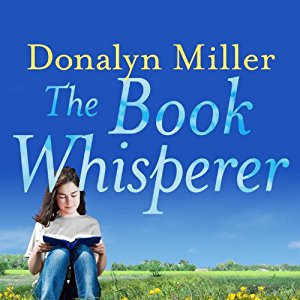How do you teach the pleasure of reading to non-readers?
Convinced by research studies and personal experience that worksheets and conventional methods of teaching literary appreciation weren’t working, sixth-grade language arts teacher Donalyn Miller took a different approach. Rather than insisting on award-winning classics or assuming that every child will like a prescribed canon, she had a goal for her students to find reading a pleasure, not a chore. So instead of assigning her whole class to read and discuss the same book over the school year, she challenged each of them to choose and read FORTY books across a broad range of genres.
After describing her initial results in her first book, The Book Whisperer, Miller was not completely satisfied that her students had become lifelong avid readers after one year in her class.
Reading in the Wild digs deeper into the habits of avid readers. In this sequel to The Book Whisperer, Miller teams up with Susan Kelley, drawing insight from surveys on her blog to suggest improvements to her method that teachers can use to help students learn to enjoy reading for a lifetime. They demonstrate how “wild readers” dedicate time to read, choose their own reading materials, share books with other readers, make plans, and develop personal canons.
Miller and Kelley are classroom teachers, so they are not writing to parents about how to model reading and create a home environment where reading is encouraged. Nevertheless, I gleaned some helpful ideas in nurturing my own young readers from Miller’s two books, and gained insight into my personal reading practices.
Based on Miller’s approach, I challenged my seven-year-old to read 100 books by the end of the year. He willingly agreed. Honestly, if he reads eighty I’ll be satisfied, and I figure that if he reads a few easier books, they will balance out the harder ones. All I ask him to do is write down the titles. Setting a goal, as Mrs. Miller did, gives us something to strive for. (Maybe next year I will also require a variety of genres.)
One difference I have with Miller is that I would not recommend all of the titles her students choose. She raised no objection when her students read books that contained questionable content. Reading should be a pleasurable activity, but some themes and issues should not be ignored when they are encountered either in life or in literature. Redemptive reading requires discernment, and book discussions with other readers are a great tool to hone those skills and discuss ideas that are outside of your experience, to determine whether the book offers truth and redemption or sin and emptiness without hope.
 Overall, both books were helpful. Here is what I took away from Miller’s books:
Overall, both books were helpful. Here is what I took away from Miller’s books:
Take opportunities to build relationships with developing readers. Take note of their interests and be open to reading their recommendations even as you offer them suggestions. I have been humbled to realize that my seven-year-old’s reading taste is not the same as my own, but he wants to share his literary enthusiasm with me as much as I want to share mine with him. If I want to encourage him to take genuine pleasure in reading, it is good for me to let him participate in choosing books, rather than forcing him to read books on a list of classics and complain that something is wrong if he doesn’t get excited right away. It is better for me to allow him to make decisions, offer input, participate in his reading experiences, and discuss themes as they arise. If I want him to know the classics, I need to be willing to sit down and read aloud, or listen to audiobooks together. I expect we’ll both grow in our family relationship, as well as becoming fellow redemptive readers.
Stay Up to Date!
Get the information you need to make wise choices about books for your children and teens.
Our weekly newsletter includes our latest reviews, related links from around the web, a featured book list, book trivia, and more. We never sell your information. You may unsubscribe at any time.
Support our writers and help keep Redeemed Reader ad-free by joining the Redeemed Reader Fellowship.
Stay Up to Date!
Get the information you need to make wise choices about books for your children and teens.
Our weekly newsletter includes our latest reviews, related links from around the web, a featured book list, book trivia, and more. We never sell your information. You may unsubscribe at any time.
We'd love to hear from you!
Our comments are now limited to our members (both Silver and Golden Key). Members, you just need to log in with your normal log-in credentials!
Not a member yet? You can join the Silver Key ($2.99/month) for a free 2-week trial. Cancel at any time. Find out more about membership here.
3 Comments
Leave a Comment
You must be logged in to post a comment.


Great write-up, friend!
One other thing I liked about Miller’s first book–she made a distinction for young, precocious readers: read fiction on their age/maturity level and nonfiction on their reading level. So helpful for those of us with young readers who are reading years above their grade level.
Ah yes, I forgot that excellent suggestion. Thanks for mentioning it!